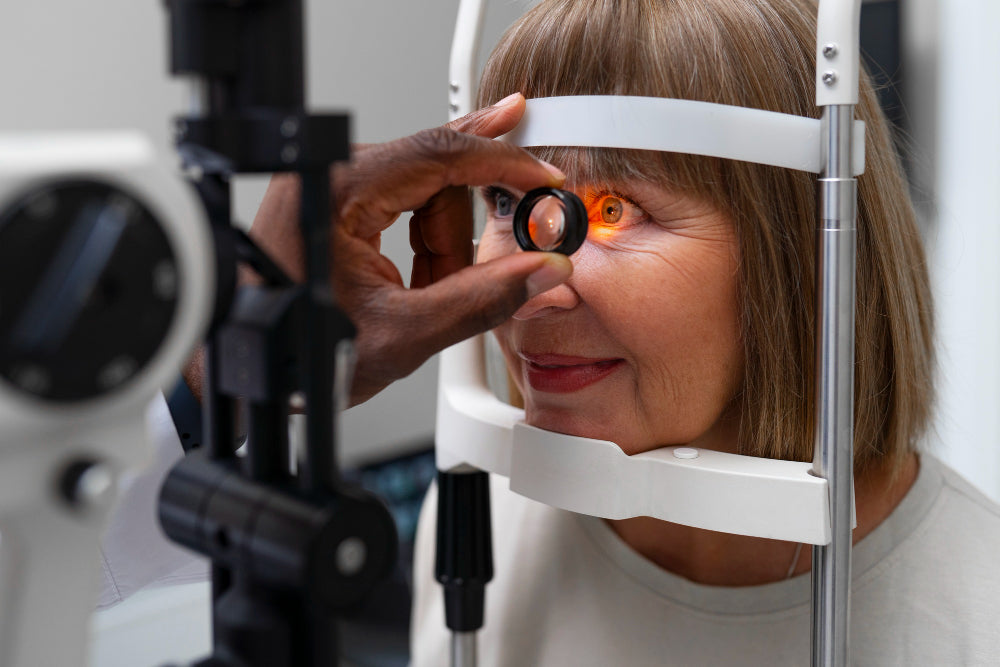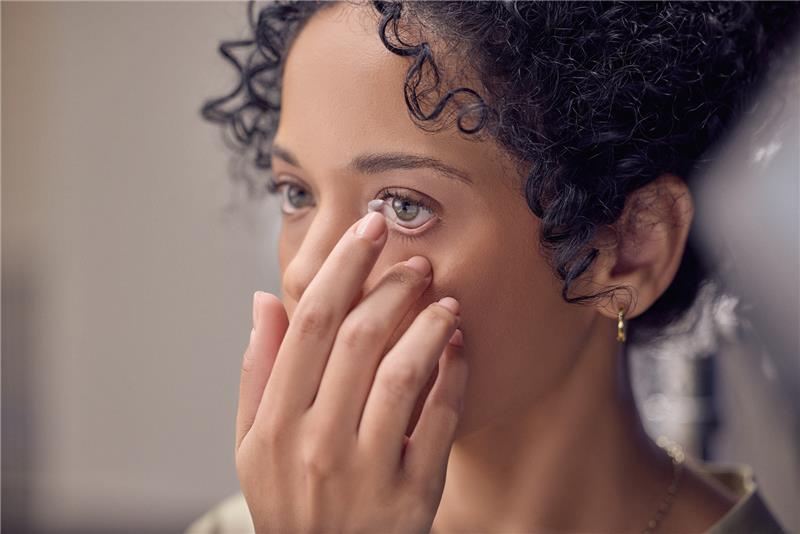You've likely experienced it—sitting in the optometrist's office, waiting for those eye drops to take effect. Suddenly, your vision blurs and everything looks brighter. But why exactly do eye doctors dilate your eyes during an exam?
The truth is there are many different reasons for dilating a person’s pupils. However, with emerging technology, like Optomap Retinal Exam, dilation is not a necessity for many patients. Vision Source Rio utilizes this technology replacing dilation for most patients aged 10-60 years old. Sometimes dilation is a necessary step in addition to Optomap Retinal Examination. For certain subsets of patients, dilation can be an important factor in ensuring eye health and clear, comfortable, binocular vision. Your doctor may need to dilate your pupils for the following reasons discussed below.
Let's explore when pupillary dilation is necessary, what happens during the process, and how it can benefit your overall vision.
What Does Dilation Mean?
When we discuss dilating the eyes, we refer to the process of relaxing the pupils open with special eye drops. The pupil is the black circle in the center of your eye that adjusts its size to control the amount of light entering it. In a normal situation, your pupils get smaller in bright light and expand in dim conditions.
However, during a dilated eye exam, eye doctors use dilating eye drops to relax your pupils open. This allows more light to enter and gives a better view of the inside of the eye. In younger people, dilation also relaxes accommodation. This step can be necessary for younger patients and patients experiencing computer eye strain to assess the true refractive state of the individual.
When Do Eye Doctors Need to Dilate Your Eyes?
Now that we understand the basics, let's get into the core question: When do optometrists need to dilate your eyes for an eye exam?
With the advent of new technology, the need for dilation can be reduced by employing Optomap Retinal Imaging. Optomap is a technology that utilizes an elliptical mirror that spins in hydrogen to image 270 degrees of the retina on the back of your eyes.
Optomap allows the doctor to store images of your retina in your electronic medical record to compare the health of your eyes year over year. It also allows the doctor to view the various layers of the retina to help identify pathology at an earlier state.
In addition, Optomap makes use of a feature called autofluorescence that further aids the doctor in identifying pathology earlier in the disease state, thus accelerating treatment and helping to prevent future vision loss.
Who is a candidate for forgoing dilation? Patients age 10-60 absent of any current systemic or eye disease, with no focusing issues and a mild to moderate spectacle prescription.
Patients with high prescriptions, children aged 10 and under, patients aged 60 and over, patients with retinal issues, and patients with certain disease states (including but not limited to diabetes) will all require dilation in addition to Optomap Retinal Imaging.
Let’s explore each reason resulting in a dilation recommendation in greater detail.
1. Patients Age 10 and Younger
First off, children and babies have very “flexible” accommodative systems. In short, this means they can focus their eyes really hard. A child can actually focus so hard that they can appear nearsighted on initial testing when they are actually farsighted.
In my 36 years as an optometrist the most extreme case I have seen was a junior high school student who initially presented as a -4.00 diopter myope who after dilation was revealed to be a +12.00 diopter hyperope! Can you guess why this student was having trouble in school??? It is estimated that 95% of teens in juvenile detention have some sort of vision problem. (On a side note this is why school screenings are simply not enough.
The aforementioned teen passed every school vision screening he ever took up until the 8th grade.) In some kids, hidden farsightedness actually causes the child to have crossed eyes, when all that really needs to happen is to have the farsightedness relaxed off with spectacle lenses to eliminate the crossing of the eyes.
You can see how this would be imperative to staving off an unnecessary strabismus surgery! But it’s also important to help a patient achieve comfortable clear binocular vision. Just because the vision measures well on initial presentation does not mean that it is comfortable for the patient and sustainable throughout the day. The only way to assess the true refractive state of an infant or child under the age of 10 is through dilation to relax the accommodative, or “focusing” system of the eyes.
In addition to excess accommodation, kids are squirmy! It’s much easier to assess the health of the inside of the eyes through a dilated pupil, even when utilizing Optomap Retinal Imaging technology.
2. Patients Age 60 and Over
Patients aged 60 and over tend to have more cloudy “ocular media”, ie, the structures inside the eye that one encounters on the way back to assess the health of the retina. The most common culprit is cataracts that occur in the lens of the eye. This time related clouding of the lens prevents good imaging of the retina and vitreous in many patients over the age of 60.
The condition of these potential cataracts needs to be assessed in addition to their effect on the patient’s vision. A plan of action for monitoring the progression of the cataracts must be put into place. For these patients, dilation aids in detecting eye diseases early.
Optomap Retinal Imaging is also important for detecting eye diseases that don't always present early symptoms. Conditions like glaucoma, macular degeneration, and diabetic retinopathy can begin developing without causing noticeable changes in your vision.
Through Optomap Retinal Imaging, with dilation as required, your doctor can detect signs of these conditions before they progress, giving you the best chance at early intervention and best possible visual outcomes.
For example, glaucoma, often called the "sneak thief of sight," can damage your optic nerve long before you notice a difference in your vision. Examining the optic nerve through Optomap Retinal Imaging with or without dilation as required allows the optometrist to catch glaucoma early and start treatment to prevent further damage and vision loss.
The measuring of intraocular pressure by means of Ocular Resistance Analysis, or ORA for short, is also key to early detection of glaucoma.
3. Patients with High Prescriptions
High Myopia (nearsightedness) and High Hyperopia (farsightedness) each present their own unique challenges to a thorough eye exam without dilation.
The patient who is highly nearsighted has an eyeball that is longer than the patient who is not. This predisposes the nearsighted patient to increased risk of glaucoma and macular degeneration. But equally if not even more important the nearsighted patient is at higher risk for retinal detachment. A longer eyeball results in the thin neural tissue of the eye, the retina (which has the consistency of wet tissue paper) to be stretched over a larger area.
This can lead to holes and tears in the periphery of the retina which can lead in turn to retinal detachment. These patients are increasingly at risk for retinal detachment as they age and the vitreous settles away from the back of the eye.
Early detection of retinal holes and tears, which can be treated with lasers in their early stages, can prevent a person from losing vision as a result of retinal detachment.
A patient with high hyperopia often cannot have the full extent of their prescription measured without dilating drops to relax off excess accommodation, or focusing by muscles inside the eyes. If the full refractive state is not measured the patient can experience eye strain, double vision, and difficulty with near work resulting from an underpowered prescription.
4. Patients with Previously Diagnosed Systemic Disease
Cancer, diabetes and hypertension are just a few examples of systemic diseases with severe ocular consequences. Patients taking Plaquenil, Tamoxifen and phenothiazines require closer monitoring as these pharmaceuticals can cause permanent damage to the retina, and the dose resulting in these irreversible changes is different for every patient. Thus frequent thorough monitoring of retinal health is required to prevent permanent vision loss in these individuals.
5. Patients with Previously Diagnosed Eye Disease
Patients with glaucoma, macular degeneration, and retinal eye disease will require dilation on an annual basis in addition to Optomap Retinal Imaging. More care must be taken with these disease states to optimize current treatment options resulting in the best visual outcome for the patient.
6. Recent Onset of Flashes and Floaters or Sudden Vision Loss
Patients who call the office concerned about recent onset of flashes and floaters may be experiencing early symptoms of retinal detachment, a devastating sight threatening condition. These patients must be seen urgently and require a more comprehensive dilated retinal examination and extensive retinal imaging. Sudden loss of vision is also an ocular emergency requiring immediate dilation. History of penetrating foreign body possibly introduced to the eye will also require dilation.
Another Important Note…
Your eyes are one of the only places where blood vessels can be observed directly without invasive procedures. When you have retinal imaging, with or without dilation as appropriate for your clinical signs and symptoms, your optometrist can examine these vessels for signs of conditions like diabetic retinopathy or high blood pressure. Both conditions can cause blood vessel changes that may not be apparent without Optomap Retinal Imaging.
An eye exam with Optomap Retinal Imaging might be the first time you hear about potential issues with blood pressure or diabetes because the blood vessels in your eyes reflect your body's overall blood vessel health.
What Happens When Your Eyes Are Dilated?

Once the dilation drops are in, you may experience some blurry vision, especially when trying to focus on things up close depending upon your prescription and your age. If you are nearsighted, simply remove your glasses post dilation to see up close.
Bright lights may also become more bothersome. This is why it's a good idea to bring sunglasses to your appointment—your eyes will be more light-sensitive for several hours after a dilated retinal exam. At Vision Source Rio we provide contemporary disposable sunglasses for patients after dilation.
The effects of dilation generally wear off in roughly 2-4 hours depending on the patient and strength of drops required to achieve the desired dilation. Some people, especially those with younger, lighter-colored eyes may feel the effects for a bit longer. Driving immediately after dilation may or may not be a problem, depending on the person. Some patients prefer to make transportation arrangements ahead of time.
Common Concerns About Dilation

Side Effects of Dilation
While the side effects of dilation are generally mild, they can include temporary blurred vision and light sensitivity. Most of these effects wear off within a few hours, but in some cases, they can last up to 24 hours. If you have concerns about your eyes being dilated for more than 24 hours, contact your doctor’s office.
How Often Should You Receive Optomap Retinal Imaging With or Without Dilation?

Quite simply, your doctor knows best. Your optometrist will recommend your examination schedule and precisely when dilation is appropriate for you based on your age, health history and current symptoms. Optomap Retinal Imaging is recommended on an annual basis.
Conclusion: Take Control of Your Eye Health
Now that you understand more about when your optometrist may prescribe dilation during your eye exam, you can see that this procedure is more than a routine check; for some patients it's essential for maintaining good eye health and clear comfortable binocular vision. And yet for other patients annual Optomap Retinal Imaging is enough. By allowing your optometrist to examine the inner workings of your eyes, you are taking a proactive step toward preventing serious eye diseases and maintaining your overall health.
At Vision Source Rio, we focus on your eye health by offering thorough eye exams customized to meet your needs. Don't wait until symptoms appear—schedule your comprehensive eye exam today and take control of your vision for a healthier tomorrow!
Ensure your eyes are in their best shape with Vision Source Rio!
Uncover More Information:





